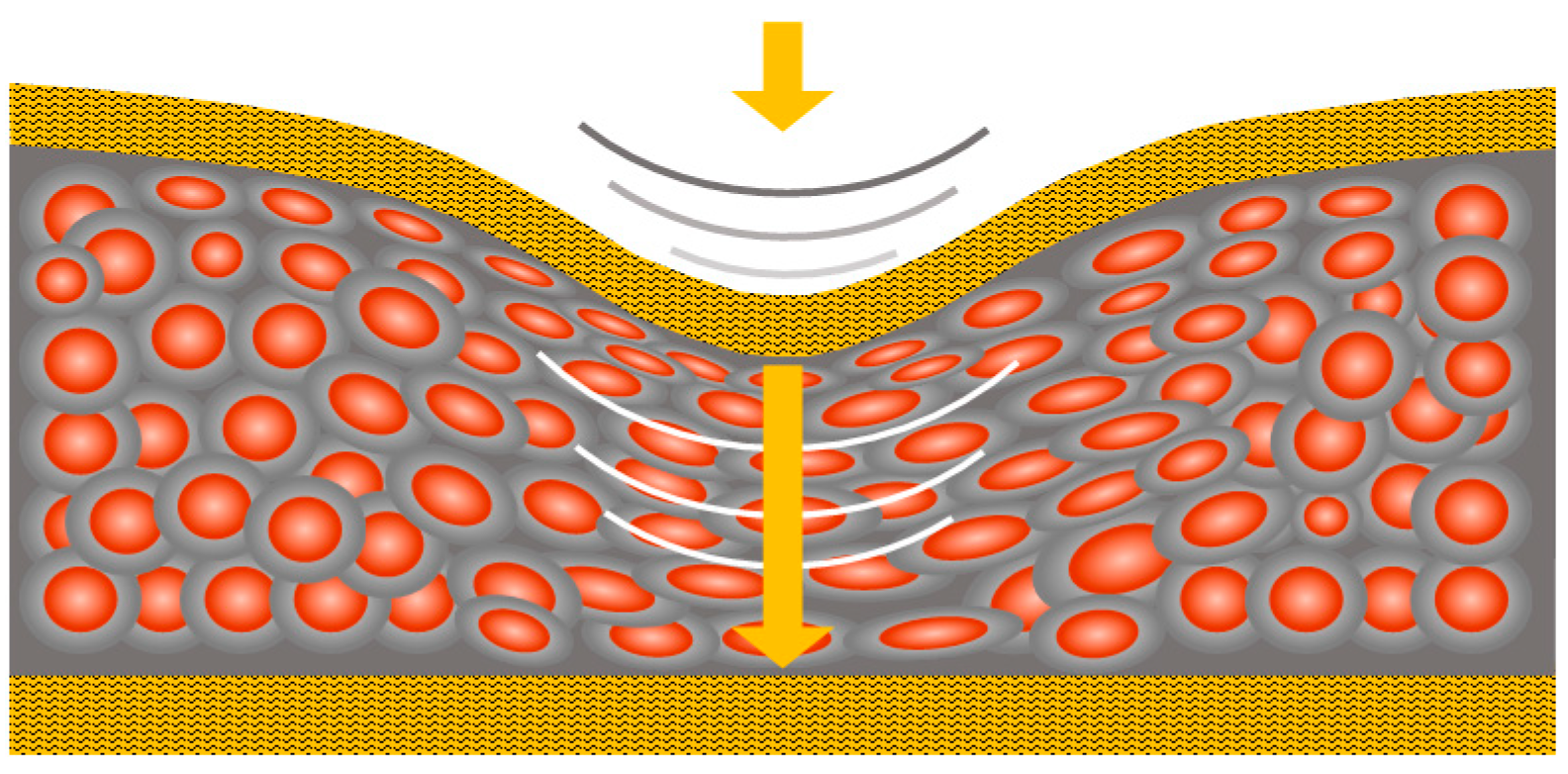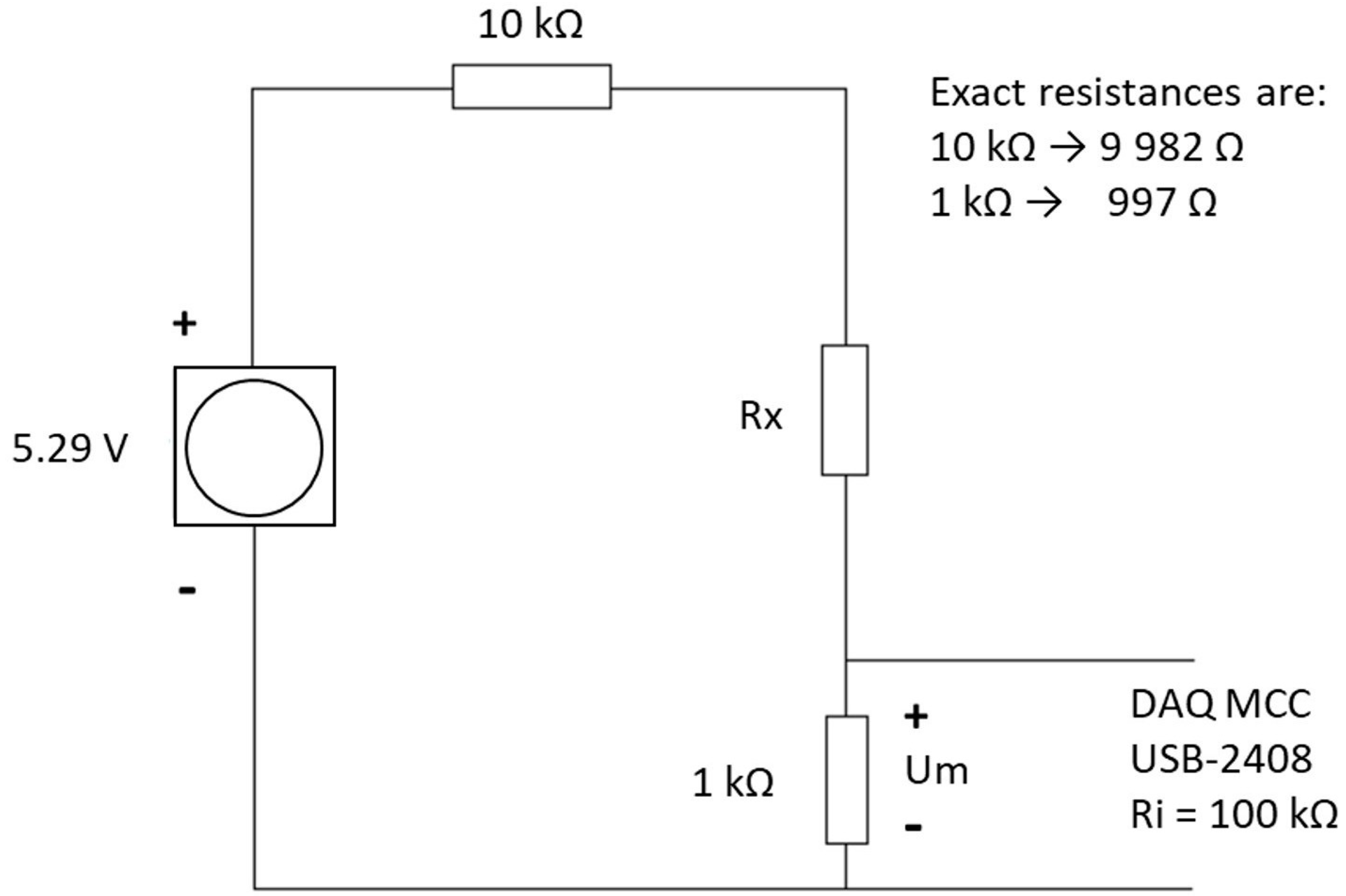Development of Prototype Low-Cost QTSS™ Wearable Flexible More Enviro-Friendly Pressure, Shear, and Friction Sensors for Dynamic Prosthetic Fit Monitoring
Abstract
:1. Introduction
2. Materials—QTSS™ Quantum Materials
3. Methods and Results
3.1. Assembly of Prototype QTSS™ Pressure Sensor Strip
3.2. Experimental Setup for Testing the QTSS™ Pressure Sensors on a ‘Flat’ Surface
3.2.1. Testing of Pressure vs. Resistance during Single Loadings
3.2.2. Testing of Pressure vs. Resistance during Dynamic Load Cycling
3.3. Experimental Setup for Testing ‘In Socket’
3.3.1. Resistance Measuring Circuit for ‘In-Socket’ Testing
3.3.2. Simulating the Pressures Caused by a Residual Limb
3.3.3. The Test Results for ‘In-Socket’ Testing
3.4. In-Socket Pilot Testing
3.5. Assembly of Prototype Shear Sensor
3.6. Experimental Setup and the Test Results for the Prototype Shear Sensor
4. Conclusions
Author Contributions
Funding
Institutional Review Board Statement
Informed Consent Statement
Conflicts of Interest
References
- Kahle, J.; Miro, R.M.; Ho, L.T.; Porter, M.; Lura, D.J.; Carey, S.; Lunseth, P.; Highsmith, J.; Highsmith, J.M. The effect of the transfemoral prosthetic socket interface designs on skeletal motion and socket comfort: A randomized clinical trial. Prosthet. Orthot. Int. 2020, 44, 145–154. [Google Scholar] [CrossRef] [PubMed]
- Ziegler-Graham, K.; MacKenzie, E.J.; Ephraim, P.L.; Travison, T.G.; Brookmeyer, R. Estimating the Prevalence of Limb Loss in the United States: 2005 to 2050. Arch. Phys. Med. Rehabil. 2008, 89, 422–429. [Google Scholar] [CrossRef] [PubMed]
- Advanced Amputee Solutions Website. Amputee Statistics You Ought to Know. Available online: https://advancedamputees.com/amputee-statistics-you-ought-know (accessed on 1 April 2021).
- Mak, A.F.; Zhang, M.; Boone, D.A. State-of-the-art research in lower-limb prosthetic biomechanics-socket interface: A review. J. Rehabil. Res. Dev. 2001, 38, 161–174. [Google Scholar] [PubMed]
- Paternò, L.; Ibrahimi, M.; Gruppioni, E.; Menciassi, A.; Ricotti, L. Sockets for Limb Prostheses: A Review of Existing Technologies and Open Challenges. IEEE Trans. Biomed. Eng. 2018, 65, 1996–2010. [Google Scholar] [CrossRef] [PubMed]
- O&P EDGE; Amputee Coalition. Amputee Patient Comfort and Compliance. inMotion. 2011. Available online: https://www.amputee-coalition.org/wp-content/uploads/2015/06/lsp_opedge-survey-article_120115-113042.pdf (accessed on 1 April 2021).
- Dillingham, T.R.; Pezzin, L.E.; MacKenzie, E.J.; Burgess, A.R. Use and Satisfaction with Prosthetic Devices among Persons with Trauma-Related Amputations: A Long-Term Outcome Study. Am. J. Phys. Med. Rehabil. 2001, 80, 563–571. [Google Scholar] [CrossRef] [PubMed]
- Meulenbelt, H.E.; Geertzen, J.H.; Jonkman, M.F.; Dijkstra, P.U. Determinants of Skin Problems of the Stump in Lower-Limb Amputees. Arch. Phys. Med. Rehabil. 2009, 90, 74–81. [Google Scholar] [CrossRef] [PubMed]
- Ali, S.; Abu Osman, N.A.; Naqshbandi, M.M.; Eshraghi, A.; Kamyab, M.; Gholizadeh, H. Qualitative Study of Prosthetic Suspension Systems on Transtibial Amputees’ Satisfaction and Perceived Problems with Their Prosthetic Devices. Arch. Phys. Med. Rehabil. 2012, 93, 1919–1923. [Google Scholar] [CrossRef] [PubMed]
- Bhandari, P.S.; Jain, S.K. Long Term Effects of Prostheses on Stump in Lower Limb Amputees: A Critical Analysis of 100 Cases. Med. J. Armed Forces India 1996, 52, 169–171. [Google Scholar] [CrossRef] [Green Version]
- IoT Tech News Website. Available online: https://iottechnews.com/news/2018/sep/28/eight-technologies-are-changing-iot-and-how-they-can-benefit-you/ (accessed on 1 April 2021).
- SocketSense Project Website. Available online: https://www.socketsense.eu/2020/05/11/new-quantum-materials-boosts-healthcare-iot-solution/ (accessed on 1 April 2021).
- EPSRC Centre for Innovative Manufacturing in Large Area Electronics Website. Available online: http://largeareaelectronics.org/what-is-large-area-electronics/ (accessed on 1 April 2021).
- Quantum Technology Supersensors Website. Available online: https://www.quantumtechnologysupersensors.com/index.html (accessed on 1 April 2021).
- Wikipedia Website—Sustainable Electronics. Available online: https://en.wikipedia.org/wiki/Sustainable_electronics (accessed on 1 April 2021).
- Organic and Printed Electronics Association Website—Sustainability. Available online: https://oe-a.org/viewer/-/v2article/render/26786968 (accessed on 1 April 2021).
- World Commission on Environment and Development. Our Common Future; The Brundtland Report; Oxford University Press: Oxford, UK, 1987; p. 8. ISBN 9780192820808. [Google Scholar]
- SocketSense Project Website—Whitepaper Sensors. Available online: https://www.socketsense.eu/2020/11/25/whitepaper-on-advanced-sensors/ (accessed on 1 April 2021).
- Össur Website. Direct Socket TF. Available online: https://www.ossur.com/en-us/prosthetics/sockets/direct-socket-tf (accessed on 1 April 2021).
- Össur Website. Reflex Rotate. Available online: https://www.ossur.com/en-us/prosthetics/feet/re-flex-rotate (accessed on 1 April 2021).
- Össur Website. Rheo Knee XC. Available online: https://www.ossur.com/en-gb/prosthetics/knees/rheo-knee-xc (accessed on 1 April 2021).
- Össur Website. ICEROSS Transfemoral Locking Liner. Available online: https://www.ossur.com/en-us/prosthetics/liners/iceross-transfemoral-locking (accessed on 1 April 2021).
- Lee, V.S.P.; Solomonidis, S.E.; Spence, W.D. Stump-socket interface pressure as an aid to socket design in prostheses for trans-femoral amputees—A preliminary study. Proc. Inst. Mech. Eng. Part H 1997, 211, 167–180. [Google Scholar] [CrossRef] [PubMed]





























Publisher’s Note: MDPI stays neutral with regard to jurisdictional claims in published maps and institutional affiliations. |
© 2021 by the authors. Licensee MDPI, Basel, Switzerland. This article is an open access article distributed under the terms and conditions of the Creative Commons Attribution (CC BY) license (https://creativecommons.org/licenses/by/4.0/).
Share and Cite
Dejke, V.; Eng, M.P.; Brinkfeldt, K.; Charnley, J.; Lussey, D.; Lussey, C. Development of Prototype Low-Cost QTSS™ Wearable Flexible More Enviro-Friendly Pressure, Shear, and Friction Sensors for Dynamic Prosthetic Fit Monitoring. Sensors 2021, 21, 3764. https://doi.org/10.3390/s21113764
Dejke V, Eng MP, Brinkfeldt K, Charnley J, Lussey D, Lussey C. Development of Prototype Low-Cost QTSS™ Wearable Flexible More Enviro-Friendly Pressure, Shear, and Friction Sensors for Dynamic Prosthetic Fit Monitoring. Sensors. 2021; 21(11):3764. https://doi.org/10.3390/s21113764
Chicago/Turabian StyleDejke, Valter, Mattias P. Eng, Klas Brinkfeldt, Josephine Charnley, David Lussey, and Chris Lussey. 2021. "Development of Prototype Low-Cost QTSS™ Wearable Flexible More Enviro-Friendly Pressure, Shear, and Friction Sensors for Dynamic Prosthetic Fit Monitoring" Sensors 21, no. 11: 3764. https://doi.org/10.3390/s21113764




